Dynamo hubs are becoming increasingly popular on touring and bikepacking bikes, thanks to advancements in LED technology and our growing need to charge USB-powered devices while on the move.
In this guide, I’ll walk you through everything you need to know about the best dynamo lights. We’ll start with the technical basics – lumens, lux, and beam shapes. Then I’ll cover features like adjustable beam modes, USB charging, and how to choose the right light for your bike.
Once you have a solid understanding of how they work, I’ll share my top picks for the best dynamo lights currently available, both for on-road and off-road riding. We’ll compare them side by side, focusing on their beam shapes to highlight how each performs in real-world conditions.
Keep in mind: there’s no one-size-fits-all solution. The ideal light for you will depend on your riding conditions, the beam shape you prefer, how much brightness you need, and whether USB charging is a priority.
This article was originally published in April 2017 but has been updated in May 2025.
Lumens and Lux
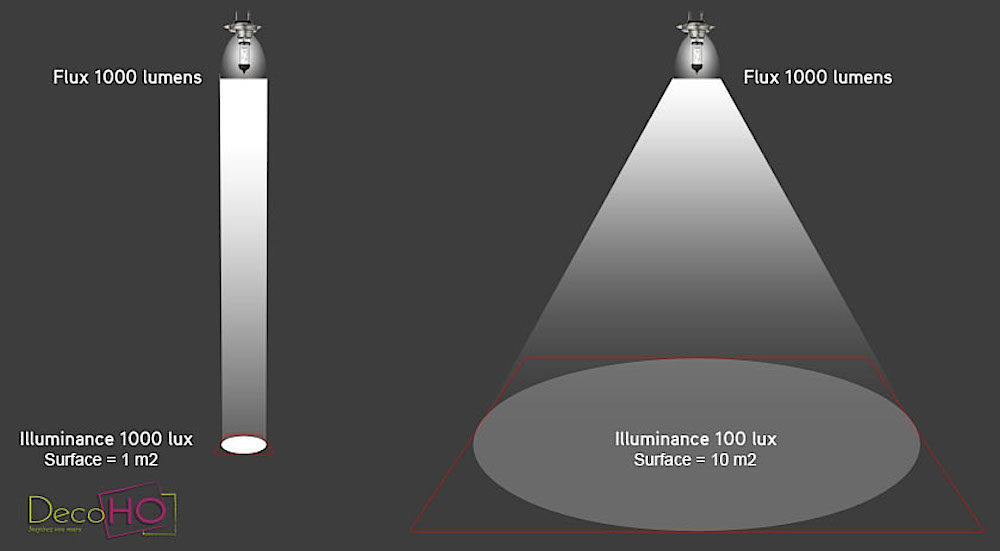
The light output at the source is measured in lumens (lm), which is a helpful unit for comparing the raw output of different LED bulbs.
Lux measures the brightness at a specific distance – that is, the amount of light falling on a surface. In Germany, regulations define lux by measuring the illumination cast on a white wall from 10 metres away.
For most everyday, non-technical riding, a light rated at 80 lux or roughly 200 lm is more than sufficient. But if you’re tackling more demanding terrain, look for lights with at least 100 lux or 300 lm for improved visibility and safety.
Keep in mind that lumens and lux reflect different aspects of performance. Two lights with the same lumen rating can deliver dramatically different results depending on how their beams are shaped. For instance, a wide-beam, high-lumen light may result in low lux, while a low-lumen light with a tightly focused beam can achieve a much higher lux value (as illustrated in the diagram above).
That’s why evaluating beam shape is crucial when choosing a dynamo light.
Beam Shape
The beam shape is arguably the most important aspect of a dynamo light.
A light might boast a high lumen output, but if it doesn’t project light where you actually need it, it’s not much use. By combining a well-designed reflector with a moderately bright LED, you can achieve highly effective illumination using a fraction of the lumens.
The most reliable way to compare beam shapes on different dynamo lights is by using a camera setup and a test rig. Don’t worry, you’ll be able to compare photos of all the different dynamo light beam shapes at the end of this article.
Here are some websites that compare dynamo light beam shapes:
Fahrrad Zukunft
Fahrrad Beleuchtung
PeterWhiteCycles
Busch & Muller
Off-Road and On-Road Lights
Dynamo lights are generally categorised as off-road or on-road, based on how they distribute light. However, many modern cut-off beam models now offer high beam modes that make them powerful enough for off-road riding as well.
Off-road lights usually feature a round beam, much like a handheld flashlight. This design is ideal for lighting objects above your line of sight, such as low-hanging branches or trail markers. Because the beam is round, these lights can also be mounted upside down without altering the beam shape.
On-road lights feature a cut-off beam designed to light up the road efficiently and safely. The beam usually begins about 50 cm in front of the front wheel and expands in both width and distance the farther it projects.
Much like a car headlight, a reflector inside the light is engineered to limit glare at eye level, reducing the risk of blinding oncoming traffic or pedestrians. High-end reflectors can also layer the light, dimming the area closest to the rider and intensifying the brightness further out where it’s most needed.
Lights with cut-off beam shapes are often labelled as StVZO-compliant, referring to Germany’s road safety regulations. These are widely regarded as the international standard for road-legal dynamo lights and hubs.
Adjustable Beam Modes
Some dynamo lights come with adjustable beam modes, allowing you to switch between brightness levels to suit different environments. A high, long-range beam is ideal for dark rural roads, while a lower, cut-off beam works better in well-lit urban areas.
This flexibility allows you to optimise visibility for changing conditions, with high-beam modes also improving illumination while cornering. Switching between modes is typically done via a handlebar-mounted control.
Light Sensors
Some lights come with integrated light sensors that automatically switch between day and night modes. These sensors typically include a slight delay to avoid reacting to temporary changes, like oncoming car headlights, ensuring smooth transitions without unnecessary flickering.
Dynamo Lights With USB Charging
Some dynamo lights include a built-in switch that diverts power from the light to a USB charging port, providing a neat and cost-effective way to charge your devices with fewer cables.
Typically, hub dynamo USB chargers perform best when the light is off, but many newer models now allow you to charge your devices and keep your lights on simultaneously. When paired with a powerful hub like the Shimano DH-UR700 or SON 29 S (which deliver up to 50% more power than standard hubs), you’ll have more than enough power for all your needs.
For a detailed overview of the best hub dynamo USB chargers, check out my resource HERE.
What Speeds Are Required For Dynamo Lights?
Most dynamo lights begin producing usable light at speeds around 8 to 10 km/h (5–6 mph) and reach full brightness between 15 and 30 km/h (9–13 mph). Below 5 km/h, illumination drops off significantly – unless you’re using a high-output hub like the Shimano DH-UR700 or SON 29 S.
At very low speeds, many lights still provide some illumination thanks to built-in standlights. These are typically powered by small capacitors that charge during your ride.
Top-tier dynamo lights often include a small internal battery or supercapacitor. These storage cells help maintain consistent brightness and reduce flicker at lower speeds, making them ideal for slow climbs or technical terrain. They also keep the light shining brightly for a short time after you stop.
I’ve listed all the best dynamo lights with built-in batteries or supercapacitors at the end of this article.
Mounting Your Dynamo Lights

Dynamo light beam patterns are generally designed for mounting at fork crown height, just above the front wheel. However, this isn’t always feasible. Alternative mounting options include placing the light higher on the handlebars, on aero bars, or atop a front rack with a tray.
Lower mounting positions, like on a rack deck or fork blade, tend to emphasise the foreground, which can lead to shadows from obstacles such as rocks or leaves. This setup may also limit your long-range vision, as the bright foreground causes your pupils to constrict, making it harder to see further ahead.
My Full Dynamo Setup Series
If you want to learn it all, it could be worth digging into my full series on dynamo setups:
Dynamo Hubs
Dynamo USB Chargers
Dynamo Wiring
Buffer Batteries
Rim Dynamos
Best Dynamo Lights: Cut-Off Beam
| Lumens @ 20km/h | Maximum Lux | Battery or Cells | USB Charging | Price | |
| Ladelux | 762 | 200 | Yes | Yes | €479 |
| B&M IQ-XL | 481 | 300 | No | No | €299 |
| Supernova | 419 | 200 | No | No | US $319 |
| Igaro C1 | 575 | 80 | Yes | Yes | £317 |
| Purple Dog | 225 | 40 | Yes | Yes | €395 |
| B&M IQ-X | 300 | 100 | No | No | US $129 |
| B&M Cyo | 260 | 80 | No | No | US $102 |
| Edelux II | 210 | 95 | No | No | US $220 |
| B&M IQ-XS | 210 | 80 | No | No | US $54 |
SON Ladelux (800+ Lm)
The SON Ladelux is one of the most impressive dynamo lights I’ve come across. It features a powerful 150-lux low beam and an even brighter 200-lux high beam, delivering excellent visibility in all riding conditions.
A built-in 1200 mAh buffer battery ensures that the high beam remains available regardless of your speed, and also keeps your USB-powered devices charged when you’re stationary.
The beam shape is notably wide and square, with consistent brightness across the entire spread. There’s a concentrated patch of illumination near the top centre, ideally positioned to reach the farthest point on the road.
One potential downside is the stark contrast between the brightly lit area and the dark periphery. With little transition at the beam edges, the intense light could make the surrounding darkness feel even darker, creating a tunnel-like effect while riding.
A standout feature is the magnetic USB connector, located on the handlebar, along with the high and low beam switch. This clever design helps prevent water ingress and makes it easy to keep your phone or bike computer topped up during long rides.
SON Ladelux
Lumens at 20kph: 762 (high beam)
Maximum Illuminance: 200 lux
Battery For Low Speed: 1200 mAh
USB Charging: Yes
Price: €479
B&M IQ-XL (600+ Lm)
The B&M IQ-XL is one of the brightest dynamo lights available, delivering the highest lux rating of any light between 25 and 30 km/h (around 260 lux) and peaking at 300 lux.
Its beam shape is impressively wide, extending several metres beyond the reach of the Ladelux on either side. Like the Ladelux, it features a focused patch of light near the top centre of the beam, aimed to illuminate the farthest point on the road, while also offering slightly more low-level illumination around the main beam.
A handlebar-mounted button allows you to activate high beam mode. At 250 lux, the high beam projects even farther and is available from speeds as low as 10 km/h, reaching full brightness just under 50 km/h.
However, the IQ-XL lacks an internal battery, so brightness does drop at lower speeds. Still, it manages to produce around 40 lux at just 8 km/h (more than virtually all dynamo lights), so you’ll have plenty of illumination even when climbing hills.
B&M IQ-XL
Lumens at 20kph: 481 (high beam)
Maximum Illuminance: 300 lux
Battery For Low Speed: No
USB Charging: No
Price: €299
Supernova M99 DY PRO (600+ Lm)
The Supernova M99 DY PRO is a high-powered dynamo light known for its exceptionally wide beam shape. Compared to models like the Ladelux and IQ-XL, the M99 offers much more low-level illumination directly in front of the wheel and to the sides, enhancing peripheral visibility and making it easier to read the terrain around you.
With 11 LEDs and advanced control electronics, the M99 DY PRO delivers up to 1,000 lumens and 200 lux. However, the light takes some time to reach its full potential – you’ll need to be riding above 20 km/h to notice a clear advantage over most 200-lumen lights, and it only reaches peak brightness at speeds over 30 km/h.
The M99 DY Pro includes both high and low beam modes, making it versatile for city commuting and off-road use. However, it lacks a battery assist, so light output at low speeds is limited and can flicker. Additionally, the beam shape isn’t very uniform – several bright spots appear in the centre, which some riders may find distracting.
Supernova M99 DY PRO
Lumens at 20kph: 419 (high beam)
Maximum Illuminance: 200 lux
Battery For Low Speed: No
USB Charging: No
Price: US $319 on Amazon
Igaro C1 (550+ Lm)
The Igaro C1 is another ultra-bright dynamo light that excels at fast device charging. At speeds above 23 km/h (14 mph), it delivers more USB power output than any other dynamo light charger on the market.
While its beam isn’t as bright or wide as some of the other models, it offers a concentrated central hotspot and a fairly broad spread. There’s also a generous amount of low-level illumination directly in front of the wheel and to the sides, making it especially useful for low-speed riding.
What really sets the C1 apart is its high level of configurability. Using a companion app, you can fine-tune how power is distributed between lighting, charging, and storage. These settings automatically adapt based on your speed, battery level, and ambient light.
Additionally, the built-in supercapacitors supply power when you’re riding at low speeds, helping to eliminate flickering and maintain a consistent, high-lumen output.
The light is housed in a single-piece CNC-machined aluminium shell, sealed for an IP69 waterproof rating. USB-C ports and sockets come with rain covers, and the toughened front glass and vibration-resistant internals make it highly durable for demanding rides.
Igaro C1
Lumens at 20kph: 575 (both beams)
Maximum Illuminance: 80+ lux
Battery For Low Speed: Supercaps
USB Charging: Yes
Price: £317
Purple Dog Companion (300+ Lm)
The Purple Dog Companion, designed and built by Nicola Banishki, combines a light and a USB charger in one unit. A handlebar-mounted remote allows you to switch between powering external devices or illuminating your path, with adjustable power levels for each mode. Impressively, it even lets you charge devices and light your way simultaneously.
The Companion has a narrower beam compared to the other lights here, focusing more light farther down the road. This makes it better suited for higher speeds rather than slower riding. It’ll be best used on tarmac roads.
Thanks to its internal battery, it can maintain full brightness at any speed, and there’s the option to dim it down to about 20% brightness when you don’t need maximum illumination. The light is available with two LED colour options: warmer or cooler.
Purple Dog Companion
Lumens at 20kph: 225
Maximum Illuminance: 40 lux
Battery For Low Speed: 1600 mAh
USB Charging: Yes
Price: €395
B&M IQ-X (300+ Lm)
The B&M IQ-X is a popular dynamo front light known for its excellent foreground illumination, making it especially useful for slower-speed riding and cornering.
With a 300-lumen output, it excels at illuminating the road ahead over longer distances, outperforming the next three lights I’ll cover. However, this combination of strong near-field and long-range lighting creates a trade-off: a noticeable dark band between the two areas.
The IQ-X also provides good side visibility, thanks to a separate LED positioned behind side openings in the light’s housing. These LEDs remain faintly illuminated even when stationary.
Overall, the light is sturdy and well-constructed with a durable metal housing. The only minor drawback is the on/off button, which has a slightly spongy feel when pressed.
B&M IQ-X
Lumens at 20kph: 300
Maximum Illuminance: 100 lux
Battery For Low Speed: No
USB Charging: No
Price: US $129 on Amazon
B&M Lumotec IQ Cyo Premium (250+ Lm)
The Cyo Premium (80 lux version) is easily one of my top recommendations in the mid-range dynamo light category. It delivers a relatively high light output with a wide and evenly distributed beam.
While it doesn’t quite pack the punch of the B&M IQ-X, the tapering beam shape results in a more even distribution of light, which will be especially nice for road use.
B&M Lumotec IQ Cyo Premium T Senso Plus
Lumens at 20kph: 260
Maximum Illuminance: 80 lux
Battery For Low Speed: No
USB Charging: No
Price: US $102 on Amazon
SON Edelux II (200+ Lm)
The SON Edelux II dynamo light is renowned for its reliability and excellent beam shape for road use. It’s the dynamo light I’ve personally used for nearly a decade without a single issue.
It shares the same reflector as the B&M Cyo Premium, so the beam shape should look almost identical. The main differences lie in the materials and construction.
The Edelux II features an anti-reflective glass lens, unlike the plastic front panel of the Cyo Premium. This allows slightly more light to pass through and significantly reduces side-scatter, which some riders find distracting (though others appreciate the additional peripheral visibility). It also boasts a durable metal housing that’s highly waterproof, offering better long-term protection than the plastic casing of the Cyo.
In terms of beam colour, the Edelux II has a slightly warmer tone, while the Cyo Premium appears a bit cooler.
At around twice the price of the Cyo Premium, the SON Edelux II is worth the extra cost only if you value its warmer beam colour, reduced side glare, and premium build quality. For added versatility, SON also offers an upside-down lens option, allowing for under-bar or low front-rack mounting.
SON Edelux II
Lumens at 20kph: 210
Maximum Illuminance: 95 lux
Battery For Low Speed: No
USB Charging: No
Price: US $220
B&M IQ-XS (200+ Lm)
The best value dynamo light I can recommend is the B&M IQ-XS. This compact light actually offers a wider beam than the SON Edelux II and Cyo Premium, making it slightly better suited for off-road use and cornering.
Its beam shape is broad and evenly distributed at moderate speeds, starting just in front of the wheel and extending up to 15 to 20 metres. However, the wider spread means it may not provide enough illuminance for high-speed descents or demanding terrain.
The IQ-XS offers reliable everyday performance and solid build quality (including a metal housing), especially impressive given that it costs half as much as the Cyo Premium and just a quarter of the price of the Edelux II!
B&M IQ-XS
Lumens at 20kph: 210
Maximum Illuminance: 80 lux
Battery For Low Speed: No
USB Charging: No
Price: US $54 on Amazon
Best Dynamo Lights: Round Beam Shape
| Lumens @ 20 km/h | Battery or Cells | USB Charging | Price | |
| kLite Bikepacker | ±1000 | Yes | No | US $500 |
| Sinewave Beacon | 451 | No | No | US $350 |
| Exposure Revo | ±500 | Yes | No | US $300 |
kLite Bikepacker Ultra V2 (1300+ Lm)
The kLite Bikepacker Ultra V2 is one of the brightest dynamo lights on this list and is designed with durability in mind. It’s fully waterproof, vibration-resistant, and built to withstand the demands of off-road riding.
Renowned for its outstanding off-road brightness, the Bikepacker Ultra is a favourite among ultra-distance racers. It provides significantly more illumination ahead and to the sides than most dynamo lights, making it ideal for slow-speed riding and tight turns. Its three horizontally mounted LEDs each contribute different characteristics, resulting in a beam that’s more oval than round.
There are two beam configurations. The ‘Race’ version (two spotlights and one floodlight) is designed to project light far down the trail, making it ideal for descending rough terrain at high speeds. In contrast, the ‘Adventure’ version (two floodlights and one spotlight) features a wider beam shape with strong foreground illumination, better suited for tackling technical terrain at slower speeds.
kLite Bikepacker Ultra V2
Lumens at 20kph: ±1000
Maximum Illuminance: -
Battery For Low Speed: Supercapacitor
USB Charging: Yes (comes in kit)
Price: US $500 (full kit)
Sinewave Beacon 2 (750+ Lm)
The Sinewave Beacon 2 is a powerful dynamo light with a round beam shape. While the light is undoubtedly bright, the beam shape is more like a narrow torch beam, so it’d actually be better for higher speed riding on tarmac roads where you don’t need to see through corners.
A key highlight is this light’s versatile power options – you can run it via a dynamo hub, an external USB battery pack, or both simultaneously. When connected to a battery pack, it also supports a blinking mode for added visibility.
It provides reliable smartphone charging at speeds of around 17 km/h, but can also power small USB devices at speeds as slow as 5 km/h.
Sinewave Beacon 2
Lumens at 20kph: 451
Maximum Illuminance: -
Battery For Low Speed: No
USB Charging: Yes
Price: US $350
Exposure Revo (800+ Lm)
The Exposure Revo is a high-quality, ultra-bright dynamo light featuring four LEDs. It reaches its maximum 800-lumen output at around 27 km/h, making it ideal for fast-paced riding.
When you come to a stop, the Revo’s supercapacitors provide up to ten minutes of light at 400 lumens. It can also continue running for up to an hour at a gradually decreasing brightness. These supercapacitors will recharge fully after just 15 minutes of riding, and help the light return to full output quickly when you’re regularly stopping and starting.
A neat feature on the back of the light is the dedicated output port for powering the Exposure RedEye rear light.
Exposure Revo
Lumens at 20kph: ±500
Maximum Illuminance: -
Battery For Low Speed: Supercapacitor
USB Charging: No
Price: US $300 on Amazon
Note: If you make a dynamo light purchase through the Amazon links, a small cut goes to supporting CYCLINGABOUT. It’s no cost to you, and the money goes a long way to creating more great resources.
My Full Dynamo Setup Series
If you want to learn it all, it could be worth digging into my full series on dynamo setups:
Dynamo Hubs
Dynamo USB Chargers
Dynamo Wiring
Buffer Batteries
Rim Dynamos




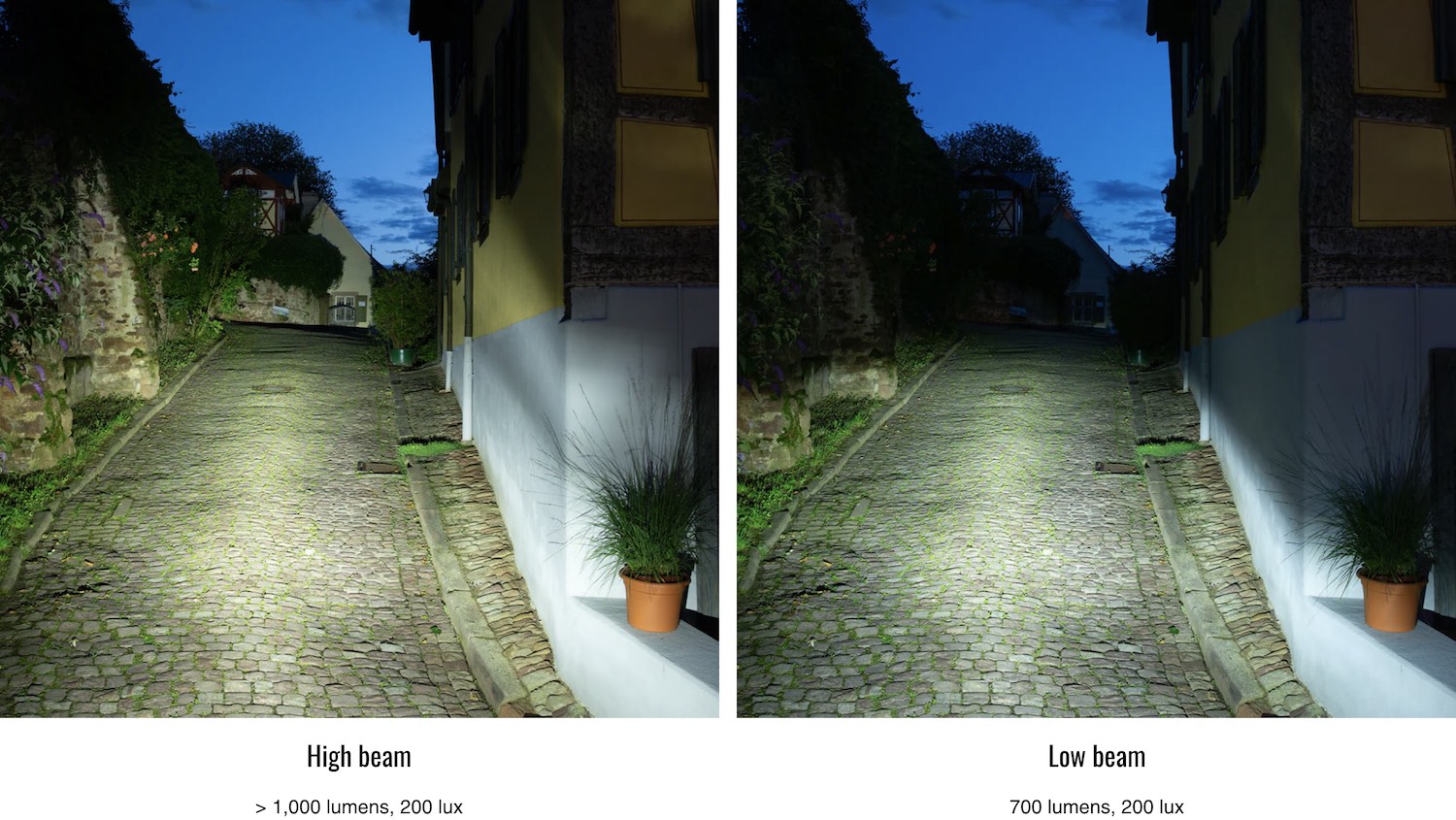
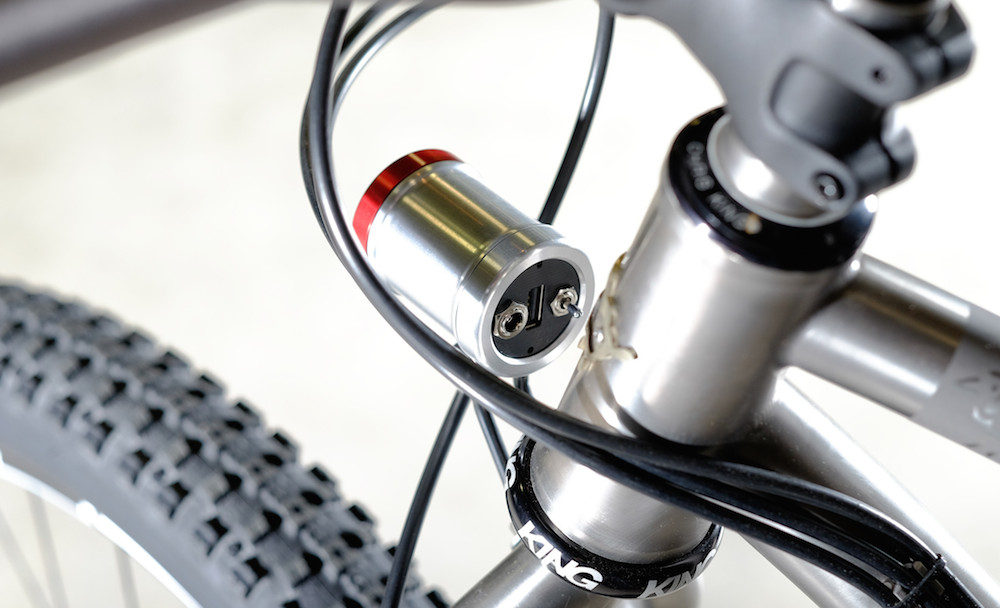
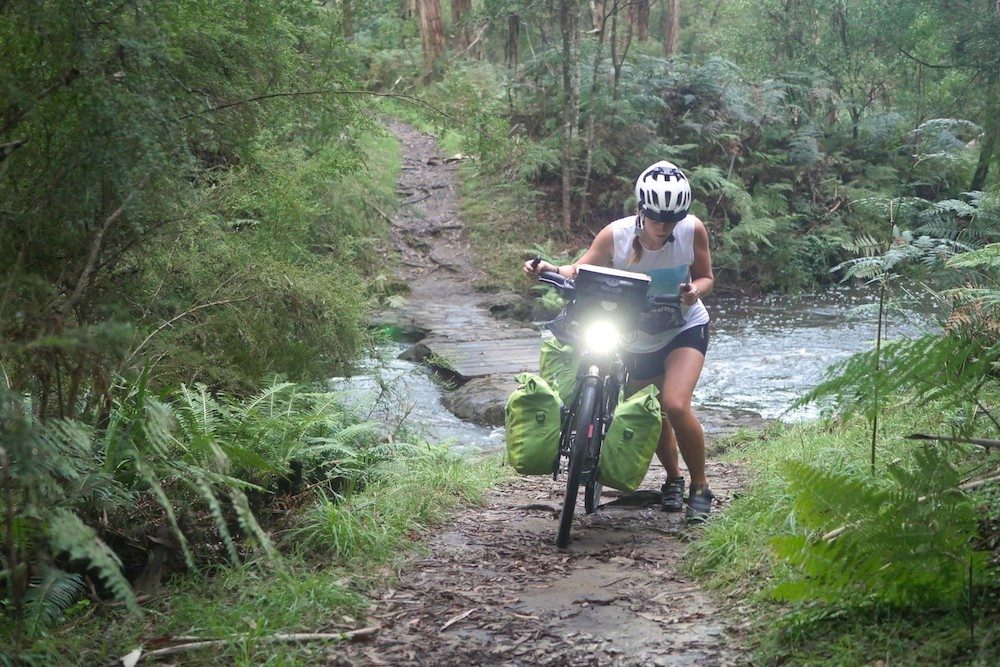












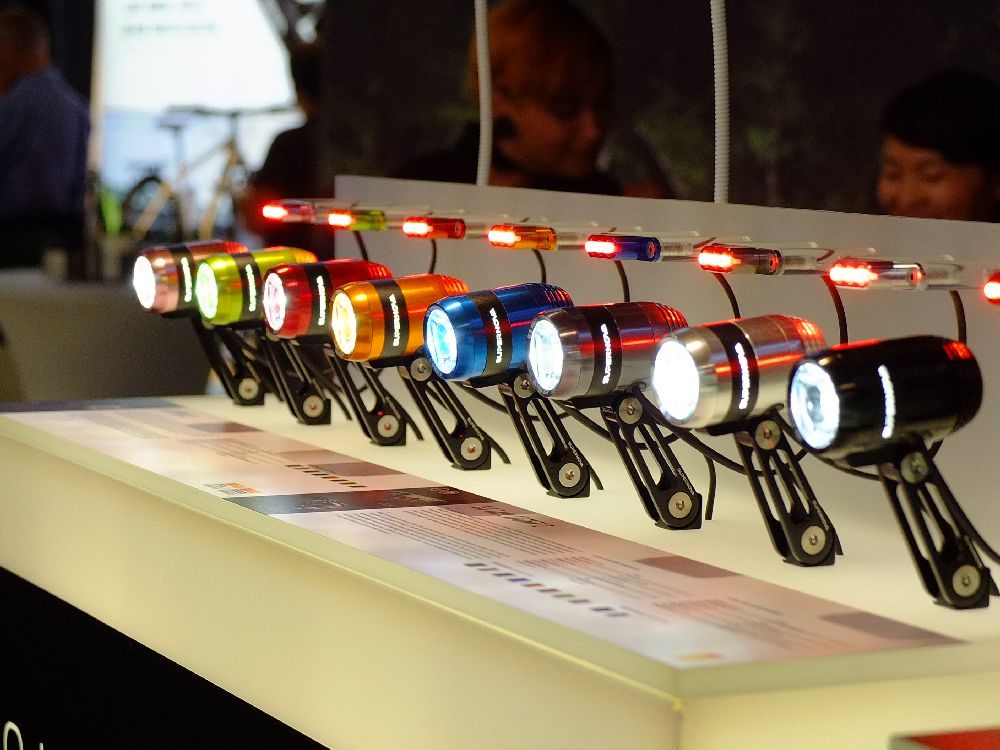
Great and very interesting article !
I have two question you write Supernova E3 Pro II at 370 lm and on the supernova website it’s 205 lm ; I am a bit lost with all those data …
The second question is about the double connection between a light and an usb converter. Is that possible to make the both working at the same time ? under which technical requirements ? (for the kLite Bikepacker Pro there is a switch) I already have a Son Dynamo and I have trouble to pick my light set.
PS: sorry for my English I am French 😉
I would add a comment on the benefits of a low-mounted front light, and the related downside of a helmet-mounted front light. A low-mounted front light will cast shadows giving the rider more detailed information about the terrain immediately ahead. Holes and ridges cast shadows and may be more easily detected with a low-mounted light than with a higher-mounted light. The higher-mounted light’s downward illumination can in-fill the shadows with light, making the relief and detail much harder for the rider to see. This is probably a bigger issue on the trail than on the road. I would not rely on a helmet-mounted light to see the trail ahead; under the handlebars should be about right provided this does not make the lamp’s illumination immediately ahead of the bike blindingly bright.
Good advice! I only use helmet lights as a secondary light when mountain biking so that I can look through corners.
Hi Sebastien. I’ve made a mistake E3 Pro II lumens. I was quoting the lumen rating of what looks to be a discontinued product with a different lens. 205lm is correct.
You can splice together the dynamo wires from a USB charger AND light to power both at the same time. But that said, you need to be going pretty fast (30km/h+) to get good use out of both. With a light like the Supernova E3 Pro II you can switch the light off entirely, so that 100% of the power will go towards charging. Most USB chargers don’t have a switch, but they will draw almost zero power with nothing plugged in. This means that putting a switch in the system isn’t all that necessary.
I am happy with my Edelux II, just don’t buy it from Peter White Cycles, find a reputable dealer and you will be happy with its performance.
Care to expound on the troubles you experienced in purchasing from this dealer?
Mr. White is old, set in his ways, and very difficult to work with. At 1st I thought there was a cognitive problem with him. I finally realized he is just a disagreeable human being that can’t admit he is wrong. He didn’t build to my specifications, and he used old and scratched components. It was a months-long continuous hassle when and if, he was ever there. After buying a multiple thousand dollar bike with only the best components he shipped a box or parts and overcharged my credit card without my approval. Once I finally got the bike, corrected the pricing (overcharged twice), and finally received all the missing parts, I put him in my rearview mirror. All I can do is give my opinion and not use his services. At the time he was the only U.S. distributor for Tout Terrain Bicycles. Being 1/2 way around the world it was easy for the Roemer Bobbsey Twins (TT Owners) to blow off the situation when I contacted them Multiple times. I think they just didn’t want to deal with Peter White either.
On the near-perfect beam shape, there is this guy at https://swhs.home.xs4all.nl/fiets/tests/verlichting/koplampen/index_en.html that argues the IQ-X is not the best, he values Roxim D6, Trelock LS906 and Axendo 60 XDAS as better.
I think the Axendo 60 XDAS is a nice option, it is cheap, only €40 and has the perfect beam shape.
I used the B&M Luxos U on a tour and found that it failed due to water ingress. Adequate water proofing is really IMHO.
The waterproofing of electronics is, of course, paramount for bicycle travel. But keep in mind that even the good stuff can fail. I’ve met ample people with the same light who’ve been cycling the world for years…
Interesting tests! I’d love to one day grab a few of those lights and test them for myself.